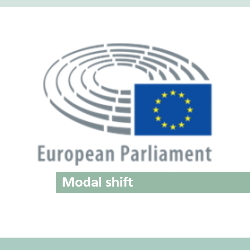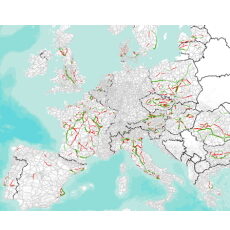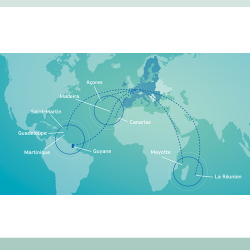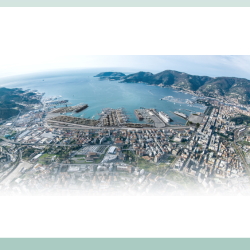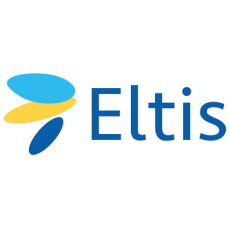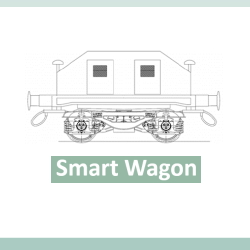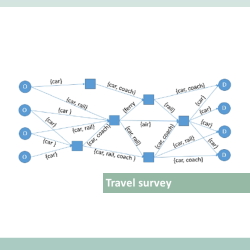- All
- African projects
- assessment
- assessment selected projects
- Assessment selected projects 2
- Assessment selected projects 3
- Assessment selected projects 4
- ASTRA
- Cost Benefit Analysis
- Electric mobility and ITS
- MOMOS
- planning
- planning selected projects
- planning selected projects 2
- planning selected projects 3
- planning selected projects 4
- planning selected projects 5
- projects
- Railways projects
- research
- research selected projects
- research selected projects 2
- research selected projects 3
- studies
- studies selected projects 1
- studies selected projects 2
- studies selected projects 3
- studies selected projects 4
- studies selected projects 5
- TRTingegneria
- TRUST
- urban mobility
- Modal shift in European transport: a way forward The study, developed for the TRAN committee of the European Parliament for the Year of Multimodality (2018), provides a comprehensive analysis of the progress and potential of modal shift in the EU from road to more sustainable transport modes, with respect to the policy objectives set in the 2011 White Paper on transport. The study focuses both on passenger and freight transport, highlighting the main barriers and factors that are hampering a more effective modal shift at EU level, providing policy recommendations for the way forward. The analysis carried out highlights that, at EU level, a modal shift from road to more sustainable transport means (rail, inland waterways, public transport) is taking place at a lower pace, compared to the objectives previously set. The relevant measures proposed, besides broadly confirming the actions so far undertaken, include the increase of investments on multimodal projects, the improvement of multimodal access and connectivity of all the EU regions and to enhance the use of ITS technologies. [tw_button icon=”” link=”https://www.trt.it/archivio-progetti/” size=”small” rounded=”false” style=”flat” hover=”default” color=”#223468″ target=”_self”]Projects[/tw_button]
- Specific contract for long-term quantitative assessment of policy scenarios for the EU transport system Since 2016, TRT holds a framework contract for the simulation of long-term scenarios relating to the evolution of the transport system up to 2050 in EU 27 Member States. Scenarios and their variants are assessed with the use of European scale simulation models by TRT and E3Modelling. The modelling tools are: TRUST, for the quantification of traffic impacts on road and rail networks and of specific emissions on the European territory; PRIMES-TREMOVE, for the quantification of the evolution of the vehicle fleet of different transport modes and of the related energy consumption starting from changes in costs and/or legislation on technologies; GEM-E3, for the quantification of macroeconomic impacts. Studies carried out under the framework contract concern the development of baselines, scenarios and variants focusing on transport, energy and macroeconomic systems and providing results at EU member state level. Within the Framework Contract a new Reference Scenario 2020 which takes into account the expected medium-term impact of the COVID-19 outbreak has been produced.
- Identification and collection of a set of indicators for the description of the urban sustainable mobility in European cities The SUMI project provided technical support for the identification and the collection of a set of sustainable urban mobility indicators in 50 European large and small urban areas. Main project activities were related to: providing rigorous and consistent methodologies for acquisition, harmonisation and analysis of data for the calculation of indicators; this included the definition of a «mentor» for each indicator, i.e. a reference experts capable to sort out all related technical issues; giving technical support to the urban areas and systematically collecting their hands-on experiences; appointed «urban area coaches» had the responsibility to establish direct links between the project consortium and the urban areas and help city administrations to gather the needed data; carrying on consultation, capacity building and dissemination actions addressed to subjects both inside and outside of the project; preparing realistic, harmonised and sound recommendations to the Commission for further improvement and extension of the indicator set; definition of an online benchmarking tool, available for European and non-European cities, aimed at comparing the indicators of each urban area with reference average values. TRT has been a key partner of the project, with direct responsibility in the coordination of data acquisition and technical assistance to the local experts, being «mentor» for four different mobility indicators. In addition, TRT experts have been «urban area coaches » for cities in Italy. The SUMI indicator set For more information: Webpage of the SUMI project on the European Commission portal. It contains the indicator set, the guidelines for the calculation of values and the benchmarking tool for the comparison of results Entire SUMI indicator set (.zip file) General harmonized guidelines for calculating the indicators (.pdf file) E-course to support cities with the application of the SUMI indicator set. Registration needed, free of charge
- Sustainable mobility territorial system within the MIBACT Salento Arco Ionico project The study is part of a wider project focused on the promotion and valorisation of tourism and cultural heritage in 12 municipalities located along the jonian coast of the Province of Lecce. The project is funded by the Italian Ministry of Cultural Heritage and Activities and Tourism (MIBACT). TRT developed a wider area cycling network to connect the towns and points of interest in the inner territory with the coastline and interlink two main long distance cycle routes crossing the area: the national Apulian Aqueduct Cycle Route and the regional «Three Seas» Cycle Route. The new plan identified each cycling segment primarily on existing rural roads. Apart for verifiyng and describing the current status and characteristics of the different itineraries (level of difficoulty, POIs, etc.), the plan detailed the needed infrastructural interventions to improve safety and quality along the networks, including punctual elements like water points and signage. TRT has also developed a scheme for the promotion of the network as cycle tourism destination. Thematic routes and itineraries (e.g. wine route, industrial heritage, natural landscapes) have been associated to services and nodes activated and managed by local companies of the tourist sector and cycling associations.
- Study on the physical accessibility of the Outermost Regions of France, Spain and Portugal The objective of the study was to develop a list of transport projects to improve the connectivity of the nine Outermost Regions of France, Spain and Portugal. The study aimed to identify the physical disadvantages, bottlenecks and missing links of the Outermost Regions. This comprehensive analysis was needed for the TEN-T policy to ensure connectivity to all European regions by 2050. The study provided a comprehensive information base of the observed transport conditions of the Outermost regions and a proposition of well-justified actions to improve the overall physical connectivity. In general, the study: identified existing transport links between the EU Member States and the Outermost Regions as well as among and between the Outermost Regions, including regional hubs; identified existing transport links between the Outermost Regions and their neighbouring countries, including regional hubs; developed an assessment of insufficient, missing and promising links; identified key investment needs regarding maritime and air transport; developed an evaluation how to strengthen the Motorway of the Sea policy and its funding; provided recommendations and a list of projects including the sources of funding. This study analysed the observed state of the transport connectivity of (i) Guadeloupe, French Guiana, Martinique, Réunion, Saint-Martin, Mayotte (France), (ii) the Azores and Madeira (Portugal) and the Canary Islands (Spain). These Outermost Regions strongly rely on air and maritime transport connections for accessing to basic goods and services, as well as for their regional economic development. The study found that, in general, the Outermost Regions are well connected with their mainland, both in terms of air and maritime transport. On the other hand, the connectivity with neighbouring regions and countries remains limited. Developing regional connectivity increases territorial cooperation and stimulates regional economic development. Therefore, policy recommendations have suggested to stimulate the level of regional integration, by optimising conditions for operators to provide regional connections through more liberal traffic rights and balanced taxation. In addition, policy recommendations on territorial cohesion aimed at improving the mobility of the residents of the Outermost Regions, as well as the conditions for transport of goods. The recommendations to support general connectivity needs focussed on the development of resilient transport infrastructures and funding options to accelerate the development of the TEN-T in the Outermost Regions.
- Financial and economic evaluation of the shore-side electrification project (cold ironing) in the new cruise terminal in La Spezia By electrifying ships hoteling activities, the La Spezia port authority aims to prevent diesel combustion from berthing vessels and avoid exhaust emissions and noise in the port areas. The objective of this project is thus to assess the welfare implications of the shore-side electrification project (cold ironing) and evaluate the feasibility of such infrastructure investment from a socio-economic point of view. Following a cost-benefit analysis approach and based on first-hand information on port traffic flows and infrastructure costs, the analysis estimates the evolution over time of both health benefits and investment and operation costs, providing a monetary quantification of the net social benefits obtained from the electrification of the cruise terminal. Taking into account relevant developments in the maritime and energy sector, such as the diffusion of natural LNG-fuelled cruise vessels and of renewables in the national energy mix, the evaluation work also provides a comprehensive assessment of the convenience of maritime transport electrification as compared to alternative policy options, and a sound case study about more sustainable approach to coastal policy and infrastructure spending.
- Eltis portal management & development The European Local Transport Information Service (Eltis) is the EU platform facilitating the exchange of information and best practices in the field of urban mobility. Expanding its services during years, nowadays it has became an Urban Mobility Observatory, providing broader services, including training materials and support tools with special focus on mutual learning. Eltis also organises the annual SUMP (Sustainable Urban Mobility Plan) Conference. The main TRT activities within this project are: Update and further development of the portal, developing new contents. Chair the ‘Coordinating Group’ meetings for the SUMPs Platform, bringing together representatives from relevant on-going EU-supported actions aiming at a) Exchange information and lessons learnt, b) Identify and exploit synergies, c) Agree on common views to inform the further development of the SUMP concept and tools. Deliver training on SUMPs, delivering national training events, Helping to bring in new cities that have not previously considered the SUMP concept.
- Automatic Rail Freight Transport System – Analysis of Transport Costs The study developed the feasibility analysis of an innovative and automatic rail freight transport system and elaborated a business plan to assess its economic and financial sustainability. The aim of introducing automatic vehicles for rail freight transport is that of enhancing the internal efficiency of the production system (e.g., in intermodal terminals and logistic centres), by reducing the operating costs and vehicles manoeuvring. Also, the use of automatic vehicles allows to optimise the shipment of cargos from intermodal terminals and logistic centres to transport networks to which they are connected. Further to this, the advantage of using automatic vehicles is twofold. First, automatic vehicles support higher safety levels of the operations avoiding internal collisions (i.e., vehicle-to-vehicle communication and knowledge of the relative position). Second, they reduce the environmental impact, optimising manoeuvring and needs of energy and fuel. The analysis developed an estimation of the operating costs of three scenarios, considering rail-road intermodal transport of semi-trailers, and compared them against the “as-is” situation as follows: wagon towed by a manoeuvring bogie equipped with a traditional coupling system; automatic manoeuvring wagon equipped with a traditional coupling system; automatic manoeuvring wagon equipped with an automatic coupling system. The estimation of the costs shows that there exists a competitive advantage for transporting by rail. With respect to road transport, the difference of cost of transporting by rail increases for longer trips and if a higher level of automation is introduced. The most important advantage of the Smart Wagon system, compared to conventional transport systems, can be obtained when specific conditions hold, namely in contexts such that the demand of freight transport is weak and spread. For example, within ports characterized by a multiplicity of connected internal terminals, the Smart Wagon system would allow to develop transport solutions that merge the demand generated in each internal terminal and share the final destination. Some aspects deserve consideration before implementing an automatic manoeuvring wagon system. First, the cost of feeder legs, which is often a critical cost component for choosing intermodal transport (i.e., the magnitude of the cost is proportional to the length of the trip). Second, with respect to transporting only via road, one should take into account the longer time of the trip, due to two modal shifts (i.e., road-rail and viceversa) and additional waiting times before the train run.
- EU survey on issues related to transport and mobility Nowadays, a reliable analysis of the transport system which allow to monitor the achievement of goals set by the European policy require the availability of updated mobility data. In line with this concept, in 2013 (and again in 2018) the European Commission launched a study involving the design of a questionnaire for a survey that investigate the mobility habits of people at European level. The survey involves 1000 individuals for each of the 28 European countries. In addition to traditional socio-demographic data and daily mobility habits, the survey deeply investigates: the role of long distance trips by mode and by purpose; the tendency to make multimodal trips; the awareness of the opportunities offered by mobile applications and innovative ICT solutions. These studies, both coordinated by TRT and implemented by IPSOS, follow the same methodological approach. This guarantees continuity in data collection allowing for data comparability, definition of trends and monitoring the impact of transport policies.

